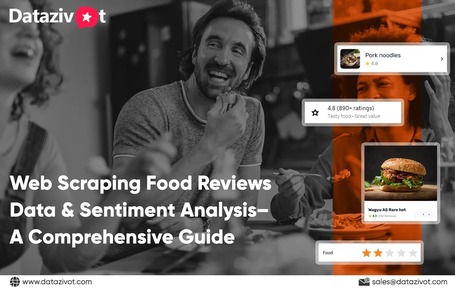


Advance your data skills today! Learn to scrape food reviews and perform sentiment analysis with our step-by-step guide. Unlock insights with ease!
Web Scraping Food Reviews Data & Sentiment Analysis – A Comprehensive Guide
Introduction
In today’s digital world, the internet is a treasure trove of data, offering insights into various aspects of our lives, including the food we eat. Restaurant review platforms and food blogs house an abundance of valuable information, providing businesses in the food industry with opportunities to understand customer preferences, dining experiences, and emerging culinary trends. This guide explores the process of web scraping food reviews and conducting sentiment analysis to uncover actionable insights and enhance decision-making in the food industry.
Web Scraping Food Reviews Data
Web scraping is an invaluable tool for collecting and analyzing food reviews. Platforms like Yelp, TripAdvisor, Zomato, and Google Reviews host millions of customer reviews, serving as a goldmine for businesses. Here’s how web scraping aids in extracting actionable insights:
1. **Comprehensive Data Collection**
Scraping reviews from multiple platforms provides businesses with diverse perspectives, enabling a deeper understanding of customer sentiments across different cuisines, locations, and establishments.
2. **Trend Identification**
By analyzing common keywords and recurring themes in reviews, businesses can identify emerging trends, helping them stay ahead in the competitive food industry.
3. **Customer Preference Insights**
Reviews reveal what customers love or dislike about dishes and services, enabling restaurants to refine menus, improve services, and exceed expectations.
4. **Competitive Benchmarking**
Scraping reviews of competitors highlights their strengths and weaknesses, guiding businesses to differentiate themselves in the market.
5. **Direct Feedback Analysis**
Scraping feedback from forms or surveys on restaurant websites provides unique insights into customer concerns and satisfaction levels.
6. **Automation via APIs**
Many review platforms offer APIs that streamline data extraction, making it efficient to access and analyze reviews for decision-making.
Scraping Food Reviews Data: Step-by-Step
1. **Identify Target Websites**
Focus on platforms with rich review content, such as Yelp, Zomato, or TripAdvisor.
2. **Analyze Website Structure**
Understand the layout of review pages and locate the key elements like restaurant names, reviews, and ratings.
3. **Choose Web Scraping Tools**
Popular tools like BeautifulSoup, Scrapy, or Selenium help automate data collection effectively.
4. **Handle Anti-Scraping Measures**
Implement strategies like rotating proxies or solving CAPTCHAs to navigate restrictions on target websites.
5. **Extract and Store Data**
Collect relevant data and store it in an organized format like a database or spreadsheet for analysis.
6. **Automate Data Collection**
Use scheduling tools to automate scraping for ongoing updates.
Sentiment Analysis of Food Reviews
After scraping food reviews, the next step is sentiment analysis—classifying customer feedback as positive, negative, or neutral. This provides measurable insights into customer satisfaction and highlights areas for improvement.
Techniques for Sentiment Analysis
1. **Lexicon-Based Methods**
Use dictionaries of pre-assigned sentiment scores to classify reviews based on the presence of positive or negative words.
2. **Machine Learning Models**
Train algorithms like Naive Bayes or Support Vector Machines (SVM) on labeled data to predict sentiment.
3. **Deep Learning Approaches**
Advanced techniques like Recurrent Neural Networks (RNNs) can capture complex language patterns for highly accurate sentiment classification.
Steps in Sentiment Analysis
1. **Preprocessing**
Clean the data by removing irrelevant text, standardizing formats, and tokenizing review content.
2. **Feature Extraction**
Convert text into numerical features using methods like TF-IDF or word embeddings.
3. **Classification**
Use models to categorize reviews as positive, negative, or neutral.
4. **Evaluation**
Measure model accuracy using metrics like precision, recall, and F1-score.
Applications of Sentiment Analysis
1. **Customer Insights**
Gain a clear understanding of what drives customer satisfaction or dissatisfaction.
2. **Enhanced Services**
Address common complaints highlighted in reviews to improve service quality.
3. **Marketing Strategies**
Leverage positive feedback in campaigns and address negative sentiments to build trust.
4. **Trend Forecasting**
Use insights to predict future trends and align offerings accordingly.
Analyzing Customer Sentiments
By integrating sentiment analysis into customer reviews, businesses can uncover:
1. **Key Topics of Interest**
Discover which aspects of a restaurant—food quality, ambiance, or pricing—draw the most attention.
2. **Actionable Feedback**
Identify recurring pain points and strategize improvements.
3. **Market Positioning**
Use insights to craft unique value propositions and differentiate from competitors.
Conclusion
**DataZivot** simplifies the complex process of web scraping and sentiment analysis, transforming raw data into actionable intelligence. By tapping into the wealth of food review data available online, businesses can better understand customer sentiments, identify trends, and stay competitive in the dynamic food industry.
Harness the power of DataZivot to unlock insights, enhance the dining experience, and drive growth. Elevate your decision-making with data-driven strategies today!
Read Full Blog : https://www.datazivot.com
